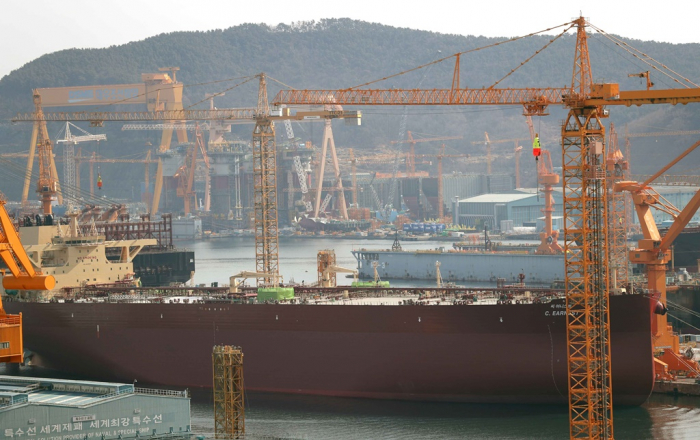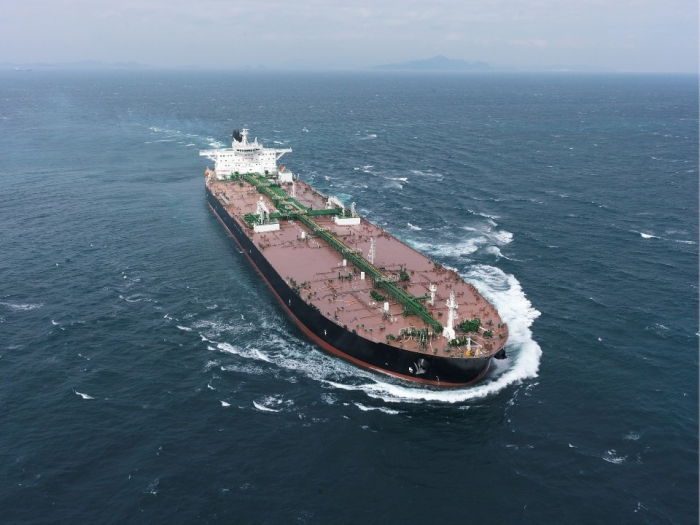Shipping & Shipbuilding
Korea shipbuilders aim for strong demand on tougher rules
IMO’s EEXI, CII regulations to cut carbon emission will take effect from 2023, requiring shipping firms to operate eco-friendly vessels
By Mar 25, 2022 (Gmt+09:00)
3
Min read
Most Read
LG Chem to sell water filter business to Glenwood PE for $692 million


Kyobo Life poised to buy Japan’s SBI Group-owned savings bank


KT&G eyes overseas M&A after rejecting activist fund's offer


StockX in merger talks with Naver’s online reseller Kream


Mirae Asset to be named Korea Post’s core real estate fund operator



South Korea’s shipbuilders targeted demand for new vessels and ship modification as tougher environmental regulations are scheduled to take effect from next year.
The industry tried to win more orders since shipping companies have been lowering engine power to cut carbon as a temporary measure with more than 80% of ocean-going ships operated by the local maritime sector failing to meet eco-friendly rules.
Shipyards have been strengthening green solution businesses such as engine power limitation (EPL) systems that reduce engine output to slash carbon, according to industry sources.
The EPL is the easiest and quickest solution for shipping companies since it takes a short period of time for installation with costs of hundreds of thousands of dollars.
Samsung Heavy Industries on March 14 said it developed its own solution to reduce carbon, based on the EPL. Hyundai Global Service, a unit of Hyundai Heavy Industries Group, teamed up with Swiss company ABB Turbocharging to offer an engine part-load optimization (EPLO) service for shipowners seeking to cut emissions in line with the International Maritime Organization’s (IMO) requirements.
TOUGHER REGULATIONS FOR CARBON REDUCTION
Such steps came as demand for ship modifications is growing ahead of the entry into force of the IMO’s Energy Efficiency Existing Ship Index (EEXI) and Carbon Intensity Index (CII) regulations on Jan. 1, 2023. They are rules to reduce carbon dioxide from existing ships. The IMO has been regulating carbon emission on newly built vessels since 2015.
The EEXI rule is to reduce carbon dioxide emitted to carry one ton of goods by one nautical mile by more than 20% compared with 2013 levels. The CII measures how efficiently a ship transports goods or passengers and is given in grams of CO2 emitted per cargo-carrying capacity and nautical mile. The ship is then given an annual rating ranging from A to E, whereby the rating thresholds will become increasingly stringent towards 2030. A ship rated D for three consecutive years, or E, would have to submit a corrective action plan, to show how the required index (C or above) would be achieved, otherwise, it won’t be allowed to sail.
The UN shipping agency aims to gradually reduce the carbon intensity of international shipping by 40% by 2030 compared with 2008 levels and 70% by 2050 through the new regulations.
“Lower rated-vessels even without direct sanctions by the IMO will be shunned by global shippers, given the growing importance of the ESG management,” said a shipbuilding industry source, referring to the environmental, social and governance. “Shipping companies won’t be able to survive without remodeling their ships to eco-friendly ones or ordering new vessels.”
ORDERS FOR DUAL-FUEL ENGINE SHIPS EXPECTED TO RISE
In South Korea, 844 ships operated by the local maritime industry out of 990 vessels registered for overseas transportation business, or more than 85%, failed to meet the EXXI standard as of the end of 2020, according to the Ministry of Oceans and Fisheries.
Almost all operators of those ships with the issues planned to install EPL systems, showed a survey by the ministry conducted after the data.
But the local shipping sector needs to take long-term measures, industry sources said.
“The EPL is an easy solution but results in a slowdown in vessel speed,” said a shipping industry source. “That will cut competitiveness eventually compared with global companies with ships equipped with dual-fuel engines that can fully comply with the environmental regulations.”

Shipbuilders expected demand for ship modification in the short term to lead to orders for high-priced vessels with dual-fuel engines in the mid-to-long term.
Write to Jung-hwan Hwang at jung@hankyung.com
Jongwoo Cheon edited this article.
More to Read
-
 Shipping & ShipbuildingHyundai, Daewoo race for ship orders after merger fails
Shipping & ShipbuildingHyundai, Daewoo race for ship orders after merger failsFeb 04, 2022 (Gmt+09:00)
2 Min read -
 Shipping & ShipbuildingBig 3 Korean shipbuilders win largest orders in 8 yrs
Shipping & ShipbuildingBig 3 Korean shipbuilders win largest orders in 8 yrsDec 31, 2021 (Gmt+09:00)
2 Min read
Comment 0
LOG IN


